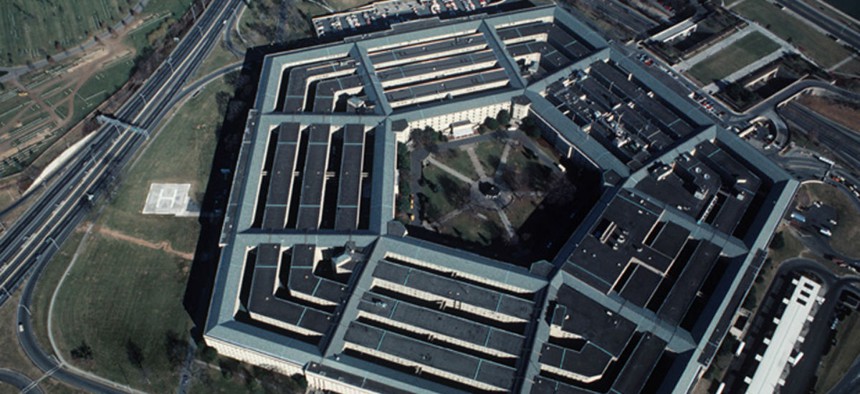
Defense Department file photo
Is Momentum Building for Another Round of BRAC?
Think tank analysts across the political spectrum urge Congress to bite bullet and close obsolete bases.
First it was Senate Armed Services Chairman John McCain, R-Ariz. Then came the drafters of President Trump’s fiscal 2018 budget request. Now it’s an ideologically diverse roster of think tank defense specialists urging a long-reluctant Congress to grab some savings by reviving the dreaded Base Closure and Realignment Commission.
On Monday, the House and Senate Armed Services panels received a letter from 45 notables—among them Gordon Adams of the Stimson Center, Michèle Flournoy of the Center for a New American Security, Derek Chollet of the German Marshall Fund, Brandon Arnold of the National Taxpayers Union, William Hartung of the Center for International Policy, Michael O’Hanlon of the Brookings Institution and Christopher Preble of the Cato Institute.
“Today, the first four BRAC rounds together are producing annual recurring savings of around $7 billion,” they wrote. “Even the much-criticized 2005 BRAC—which focused mostly on realignment of functions at existing facilities, and closed far fewer bases than in preceding rounds—is producing nearly $5 billion in annual savings.”
Urging Congress to act now, the authors argued that “BRAC has proven to be a fair and efficient process for making the difficult but necessary decisions related to the configuration of our military’s infrastructure. In the absence of a BRAC, defense communities are hurting. Although members of Congress have blocked base closures with the intent of helping these communities, they are actually making the problem worse.”
Lawmakers seeking to fend off base closures in their home districts often say that overseas bases should be considered first for closure, the letter continued. Such members who “profess great concern about cutting waste” are being “disingenuous,” the critics wrote. “The Pentagon retains the ability to close military facilities not on U.S. soil, and has done so, but Congress has blocked closures here at home for over a decade.”
President Trump’s 2018 budget released in March and expanded in May noted that the Defense Department “has approximately 20 percent excess infrastructure capacity across all Military Departments,” and estimated that a new BRAC round in 2021 could generate $2 billion or more in annual savings by 2027.
The Obama administration had also pushed repeatedly for a new BRAC, most recently in an April 2016 report in which Deputy Defense Secretary Robert Work noted that the department’s overall “excess capacity” for bases was 22 percent, broken down as the Army (33 percent), the Navy (7 percent), the Air Force (32 percent), and the Defense Logistics Agency (12 percent).
But that report, required under the National Defense Authorization Act, was not convincing to Rep. Mac Thornberry, R-Texas, the influential chairman of House Armed Services.
“The capacity report the Pentagon belatedly delivered to Congress simply doesn’t tell us what we need to know,” he said in an April 2016 statement. “In envisioning a military far smaller than anyone thinks is wise, it fails to comply with the law as badly as it fails to justify a BRAC round. No one believes that the current military force structure is adequate to meet the threats we face. Just this month, senior commanders testified that our military is too small. Assessing our capacity based on an inadequate force structure makes no sense. It would lock in a future where our stressed military becomes permanently gutted.”
After Trump’s election, however, McCain told a January 2017 hearing that he will consider another military base closing round in the near future, calling Congress’ handling of the issue “cowardice” and a threat to military readiness. He drew backing from Sen. Jack Reed, D-R.I., the ranking member on the Senate Armed Services Committee.
Even more enthusiastic is Rep. Adam Smith, D-Wash., ranking member on the House panel, who said Tuesday in a statement to Government Executive that “it’s positive to see that the Trump Administration has recognized the value of a new Base Realignment and Closure round. This is an important way to help the military cope with the constraints imposed by Congress’ inability to repeal the Budget Control Act, and allow DoD to redirect taxpayer money that is currently wasted on excess infrastructure toward more important defense priorities. Congress should take lessons learned from the previous BRAC round, make improvements to the process, and help the Department reduce its excess infrastructure capacity.”
In January, Smith introduced the 2017 Military Infrastructure Consolidation and Efficiency Act (H.R. 753). It would give the Pentagon base-closing authority beginning in 2019 and allow it to make targeted reductions while creating a strategic reduction plan. The usual BRAC independent commission would be empaneled to review the Pentagon’s recommended closings subject to an up-or-down vote by Congress on the whole package. But the bill would also enhance congressional oversight of the efficiencies sought and require the Pentagon to consider the local jurisdiction’s views on closing a base.







